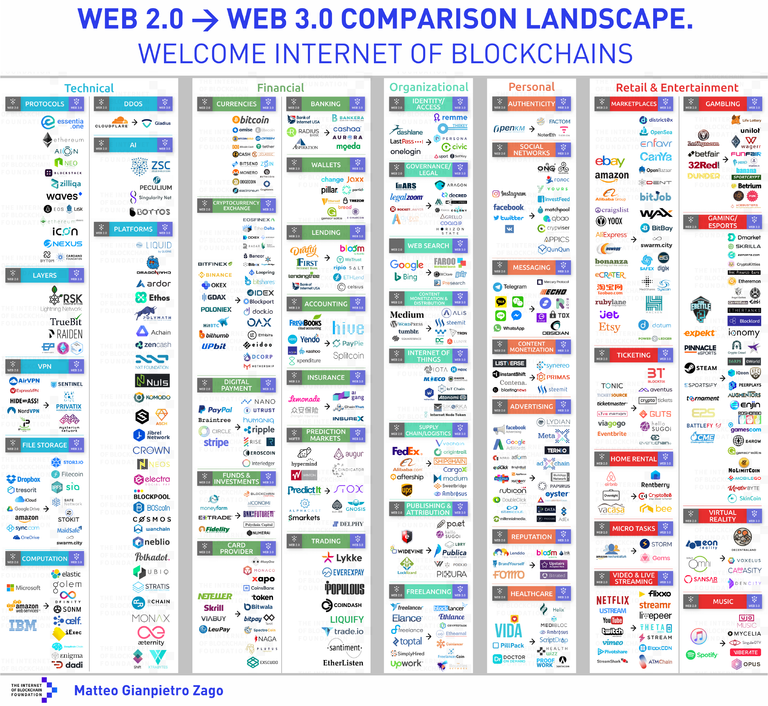I came across an great image courtesy of Niel Harper’s Linkedin profile comparing how blockchain platforms relate with day to day applications. This is a great visual by Matteo Gianpietro Zago of The Internet of Blockchain Foundation.

IMAGE BY MATTEO GIANPIETRO ZAGO OF THE INTERNET OF BLOCKCHAIN FOUNDATION
blockchain is a continuously growing list of records called blocks, which continues to grow as new records are added on top of each other. The blocks are linked and secured using cryptography (NARAYANAN, Arvind et al., 2016). Blockchain enables storage, validation, authorisation, and moving digital transactions across the Internet. The blockchain has its origin with the Bitcoin, which is a cryptocurrency, a form of virtual money and was the first blockchain implementation, conceptualised by a paper released in 2008 by Satoshi Nakamoto (NAKAMOTO, Satoshi, 2008).
Considering that coinmarketcap.com is now monitoring over 10,000 markets, this graphic above may not even have scratched the surface. It may not have captured the obscure blockchain technologies that will disrupt the market. But it is a great start nevertheless.
Although blockchain is not a solution for all problems, it is really good where Autonomous Organisations can flourish, and where Trust is a big issue.
According to Matteo Gianpietro Zago, the technologies on the right of the image above represents web3.0, while those on the left represent web2.0. e makes good points on interoperability, uninterrupted services, and permissionless blockchain. In Web2.0, data has coalesced in a few individuals, the Google and Facebook of this world. He sees Web3.0 bringing decentralised platforms where information is not under the control of a few. I see this not materialising. To me, data is like wealth … it is really wealth. Wealth has a way of accumulating with the few, the majority being the cogs that drive the wealth to the few. In web3.0, or in a decentraised internet, it will not be any different. The schemers will still find a way of accumulating data, and influence, and control into the hands of a few. A good example has been the Bitcoin core scaling debates. Control of Bitcoin core has still remained in the hands of a few. These are entities who have already booked a seat at the table, running mining servers, learning the tech, contributing to the core tech, innovating and re-inventing. They already have a headstart. And the big multinationals have not been left behind. IBM, Google, Oracle, and Microsoft have already plunged into experimenting with blockchains.
Anyway, the purpose of this writeup is to appreciate how easy it is now to compare distributed decentralized applications to their non distributed counterparts as shown below. It makes it easier for beginners in the blockchain and crptocurrency tech to understand what the new tech is doing, and the problem it is trying to solve.
COMPUTATIONAL APPLICATIONS
Microsoft, AWS, IBM >> elastic, golem, somn, enigma, dadi
FILE STORAGE APPLICATIONS
Dropbox, icloud, amazon, onedrive >> IPFS, Filecoin, storj, maidsafe
CARD PROVIDERS
skrill, viapay, Visa >> Monaco, bitwala, bitpay
CONTENT MONITIZATION and DISTRIBUTION
Medium, WordPress, Tumblr >> Steemit, Alis, Tron, Synereo, Primas
SUPPLY CHAIN
FedEx, Alibaba, UPS >> Vechain, Origintrail, Shipchain
SOCIAL NETWORKS
Instagaram, Facebook, Twitter >> Akasha, Crypviser, QunQun
SHARING ECONOMY
Airbnb, Overnight, Vacasa >> Rentberry, Cryptobnb, Bee
MARKETPLACE
Amazon, Ebay, Alibaba, Craiglist >> Datum, syscoin, bitpay, openbazaar, bitjob, Safex, digix, power ledger
GAMING
Expekt, pinnacle sports, Battlefy >> Enjin, NoLimitCoin, Skincoin, Blocklord, Cryptokitties
Congratulations @lordmwesh! You received a personal award!
You can view your badges on your Steem Board and compare to others on the Steem Ranking
Do not miss the last post from @steemitboard:
Vote for @Steemitboard as a witness to get one more award and increased upvotes!